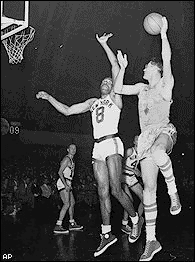First National Tournaments - I
The first post-season college basketball tournament began as an initiative of a group of sportswriters, not the NCAA.
- The Metropolitan Basketball Writers Association sponsored the first National Invitational Tournament (NIT) in 1938. The "Metropolitan" in the title of the organization referred to New York City, where the association was founded in 1934.
- The first tournament was held - where else? - at Madison Square Garden in New York.
- The initial NIT capped off the first season in which the center jump after each basket was eliminated.
- 1937-8 also saw the end of Hank Luisetti's sensational career at Stanford in which he tallied an unheard of 50 points against Duquesne. Although the Indians won a third straight Pacific Coast Conference championship, they were not invited to the NIT - probably because of the cross-country travel involved (which would eat into the profit generated by the tournament).
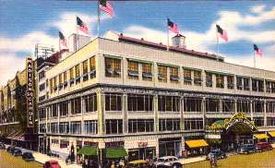
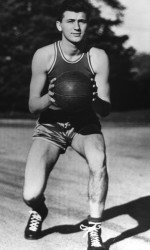
L: Madison Square Garden #3 (1925-1968); R: Hank Luisetti
Six teams were invited.
- The teams that had to travel the furthest distance received first round byes: Oklahoma A&M (24-2), kings of the Missouri Valley Conference, and Colorado (14-5), co-champions with Utah of the new Mountain States Conference.
- The other four squads came to New York for a first round doubleheader on Wednesday, March 9.
- Temple (17-2), champions of the Eastern Conference
- Bradley (18-1), Illinois conference titleists
- New York University (15-6)
- Long Island University (23-3)
First round
Game One
- To quote the United Press writer: "Temple's towering Owls turned on a dazzling offense to crush Bradley Tech of Peoria, Ill. 53-40."
- Temple was "Eastern Conference champion and heavy favorite to win the first tournament title."
- The Owls, led by All-American Meyer Bloom, scored more points against the midwesterners than any team that season.
- Ahead 25-12 at the half, Temple extended their lead to 21 points before coach James Usilton put in his reserves.
- An interesting paragraph from the UP article on the game:
Quick action by Referee Bill Soldare prevented Don Henderson, of Temple, and Dar Hutchlns, of Bradley,from coming to blows in the second half. Henderson was trying to take the ball from Hutchins and thelatter said something, clenched his fists and started toward Henderson. Soldare intervened. Bradley coach Alfred J. Robertson (still the winningest in school history) said afterwards: "Our team was way off. Temple has a zone defense system, and it was the first time my boys had worked against it."
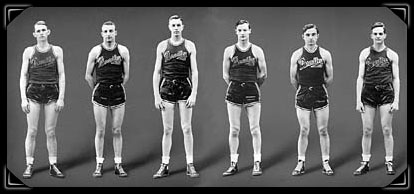 
L: Bradley's "Famous Five" (actually six) 1937-9; R: Coach Alfred Robertson
Game Two
The meeting of the two Big Apple teams produced an exciting comeback by the underdog. New York U., minus the services of its Captain Jerry Tarlow, who turned professional this week, trailed the Long Island Blackbirds from the start to within three minutes of the final whistle.
- Claire Bee's LIU quintet led by as much as 10 in the first half before going to the locker room with a 20-14 advantage.
- NYU lay dormant until midway through the second 20 minutes when "the Violets suddenly came to life and began to make a fight of it, putting on one of the grandest rallies ever seen in the garden."
- NYU brought the count to 36-36 three minutes from the end, then Danny Dowd, forward, caged a field goal from a reclining position on the floor after being knocked sprawling and gave the Violets a two point lead.
- After an LIU FT, NYU extended the lead back to 2 with one of their own, then held on in the final seconds.
The next day, a drawing was held to determine the pairings of the first round winners with the western teams for the semifinals on Monday, March 14.
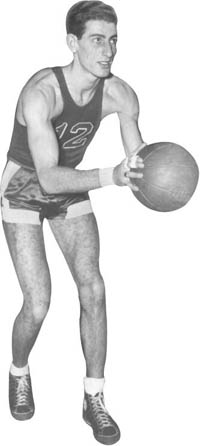 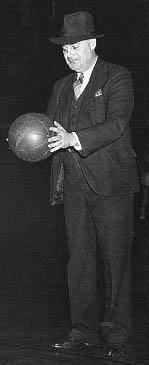
L: Meyer Bloom; R: James Usilton |
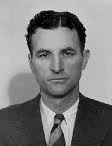 Claire Bee
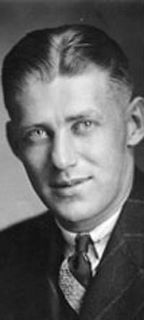
Hank Iba |
Semifinals
Game One
- In the first of "two of the fastest basketball games ever staged in Madison Square Garden," Temple steamrolled Oklahoma A&M 56-44.
- "The Owls could not miss in a dazzling display of marksmanship as they streaked off the mark to a lead and never were headed."
- Temple led at the half 26-17, and Hank Iba's Aggies never got closer than 5 the rest of the way.
Game Two
- More than 12,000 "excited fans" - nearly all presumably pulling for the hometown team - saw Colorado nip NYU 48-47 on Don Hendrick's set shot in the last ten seconds.
- The yellow-jersied Buffaloes opened a 10-point lead in the first half only to have the Violets pull to a tie in the opening minutes of the second half.
- From then on, it was a nip-and-tuck battle with four ties and neither team able to gain more than a 3-point advantage. The lead changed hands twice in the final half minute.
- One of CU's leaders was Byron "Whizzer" White, their gridiron star who joined the team in January after the Cotton Bowl (and future Supreme Court justice). He popped in a short shot to give the Buffs a 46-45 lead.
- Then Bernie Carnevale canned a short from the corner to put NYU back in front with 25 seconds remaining.
- But Hendrick, a sophomore, "fired away from dead center and never even touched the rim" to deflate the exhausted crowd.
- Colorado's starting five played the entire contest.
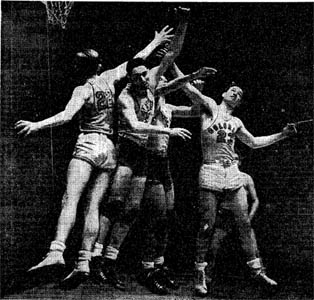 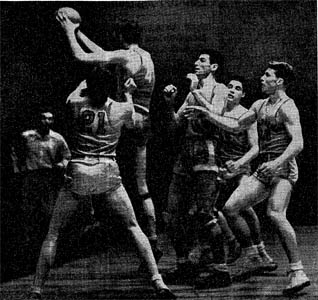
L: Semifinals action between Colorado and NYU; R: Temple's Don Shields grabs a rebound in the finals.
Finals
- After Oklahoma A&M "gave a superb ball-handling exhibition" in defeating NYU 37-24 in the consolation game, 14,497 spectators settled back for a rousing championship game.
- Unless they had come from Philadelphia, fans were roundly disappointed as the Owls jumped out 10-1 and led 33-18 at the half on their way to a 60-36 romp over Colorado.
- Here's how Arthur Daley of The New York Times described the action.
Temple was so red hot it was afire. The crowd just sat there and gasped in astonishment. It never had seen such shot making. Not only was it the point-getting that impressed but the way the Eastern Conference champions made the nets dance.
They pegged bullet passes so high in the air that none but their own giants could catch them. And they shook loose men in easy lay-ups, pegged long range baskets from all sections of the floor and curled in dazzling hook shots that were slightly more impossible to stop than they were to make.
- On defense, Bloom and Henderson, two 6'6" goal-tenders, "batted away nearly everything in sight and clamped down on the Buff shooters like a net."
- To this day, Temple proclaims its 1938 team as "the first ever national champions in collegiate basketball." (LSU makes the same claim for its 1934 team.)
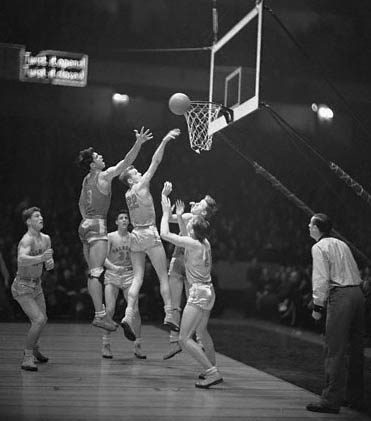
Don Henderson (#3) jumps for a rebound in the Temple- Colorado NIT final.
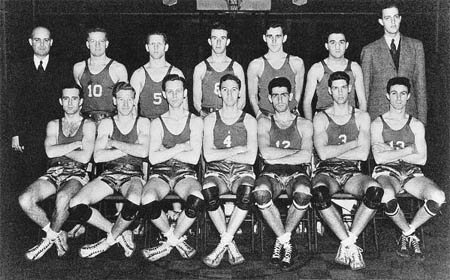
Temple Owls, champions of the first NIT
As we shall see in Part II, the coaches association, undoubtedly emboldened by the success of the first NIT, tried its hand at sponsoring another post-season tournament in 1939.
First National Tournaments - II
The first national tournament in 1938 was sponsored by the basketball writers of New York City.
- A group of coaches in the National Association of Basketball Coaches (NABC), led by Harold Olsen of Ohio State, felt that any national tournament should be sponsored by a collegiate organization and not scribes, particularly those with a "biased" Eastern attitude.
- So the NABC, after "lengthy and somewhat tiresome" meetings at its annual convention, decided to sponsor a tournament following the 1938-9 season.
- Put in charge, Olsen appointed committees of three or four coaches each to select a representative from each of the nation's eight districts.
- The tournament provided competition for the second National Invitational Tournament at Madison Square Garden, which was won by Long Island University.
Four teams gathered in Philadelphia at the University of Pennsylvania's Palestra to determine the champion of the Eastern half of the country.
- Hometown Villanova upended Brown 42-30, and Ohio State set three records in besting Wake Forest 64-52.
- The Buckeyes' 64 points represented the highest score in the 13-year history of the arena.
- OSU's Dick Baker broke the existing individual scoring mark with 25.
- The combined 116 points by Ohio State and Wake established a record for total points in a game.
- The Buckeyes then trounced the Wildcats 53-36 to earn a spot in the championship game of the tournament he spearheaded. OSU's captain, James Hull, canned 28 to break Baker's record.
- Remarkably, despite the fact that their coach was head of the committee, Olsen's team didn't even know about an NCAA tournament until after they won the Big Ten title. In fact, he was somewhat embarrassed: "I'm chairman of that committee that organized this tournament and here my team wins it."
Meanwhile, the Sports Coliseum on Treasure Island in San Francisco hosted the representatives from the four western districts.
- Oregon ran over Texas 56-41 in one semifinal while Oklahoma took out Utah State 50-39 in the other. The Sooners had to win a playoff in its district over Drake and Oklahoma A&M to earn its spot in the tournament.
- Then the Ducks, called "The Tall Firs," ousted OU 55-37.
- In contrast to Ohio State, Oregon's players were aware from the start of the season that there would be a national championship to shoot for.
The total attendance of 9,525 at the two sites was disappointing. Surprisingly, the San Francisco crowds exceeded those in the more populated East.
The squads in the Final Two employed starkly contrasting styles.
- Oregon's veteran team, called "The Tall Firs," relied on speed as well as height. The size of the front line was rare in that era: Two 6'4" forwards, Laddie Gale and John Dick, the only junior starter (and a future admiral), and 6' 8" C in Urgel "Slim" Wintermule.
- Howard Hobson coached an up-tempo game, as he later explained:
Our fast break was a little unusual in that we looked for it on every possession. We used it all the time until the opportunity closed. It was a break that we always attempted after we gained possession, with the two guards handling the ball most of the time, the two forwards down ahead, and the center trailing and coming in on the rebound.
- That philosophy often produced two-on-one and three-on-two opportunities. As Gale explained:
I'd call it a controlled fast break. There was nothing reckless about it. We knew where we were going, and we knew where to expect our teammate to be. And when the situation would present itself, we were there. Prior to that, many who used fast breaks would just have five men run down the floor, get a long pass or something and throw the ball up.
- To prepare his team for the conference season, Hobson scheduled an across-the-continent trip during the break between semesters. He said later:
I believe the making of our team came in December of 1938 when we pioneered an Eastern trip for teams from the Northwest. We played 10 games in 22 days, traveling from Eugene to New York City by train. ... Because of playing all through the rest of the country, we were ready for any kind of officiating on any kind of court.
- The Ducks considered the championship game the last step in their crusade to gain respect for West Coast basketball. Hobson along with all five of his starters were Oregon natives.
Ohio State played the more physical half-court game typical of the Big Ten.
- The Buckeyes, who prided themselves on their defense, suffered a setback when captain Hull suffered an injury in the second half of the East championship game. He explained years later:
It was the only injury I ever had in college. I took a rebound, and a fellow came down and lit on my ankle. I was in so much pain, they had to carry me to my hotel. I was so bandaged, I felt I had all the tape in the drugstore on me.
- Even a week to rest his ankle wasn't enough. Although he scored 12 in the finals, Hull said:
I don't mean to be a braggadocio, but had I been able to shoot my normal percentage from 18 to 20 feet out, from which I was accurate in those days, I think I could have kept our ball club in the game. But I was hurting. I could shoot, I could get open against Oregon, but I wasn't as accurate as I usually was.
- Hull also cited his team's lack of motivation.
Our ball club was so tired of basketball at the end of the Big Ten season that we were not even interested in playing in this tournament. I don't mean to take it lightly. It was just that it was a new tournament - unheard of. There was no publicity about it.
Hobson had done his homework much better than Olsen.
We never even knew what teams were competing in the West. In fact, after we won our Eastern tournament, there was very little said to us about whom we may even play. We were blind all the way through this thing. We knew practically nothing about Oregon. We had no idea they had all that height. We had nothing to practice against.
- On the other hand, Oregon didn't know much about their opponent by today's standards but still trumped OSU. Dick recalled:
We had some knowledge about Ohio State. We knew all about Hull, their leading scorer. We knew their starters were not very big compared to our team.
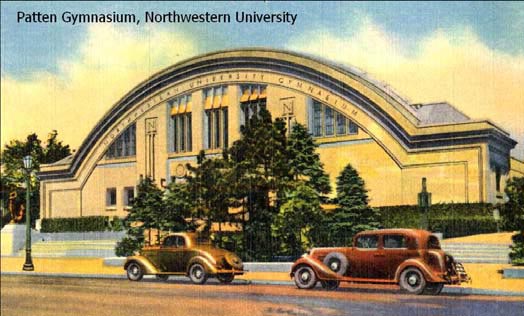 |
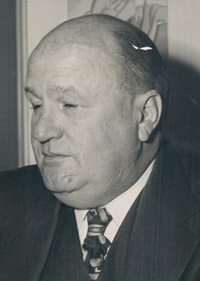
Harold Olsen
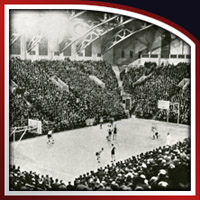
The Palestra, U. of Pennsylvania, opening night 1927
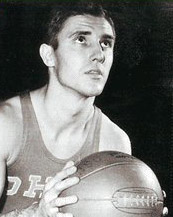
James Hull
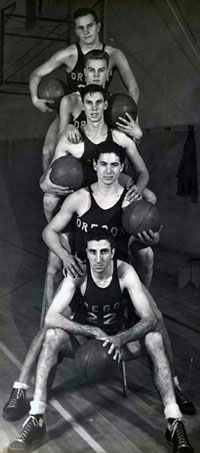
Oregon "Tall Firs"

John Dick
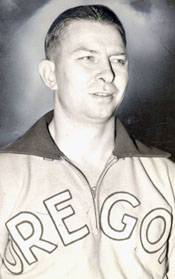
Coach Howard Hobson
|
So on March 27, Oregon met Ohio State at the Patten Gym, constructed in 1910 on the campus of Northwestern University in Evanston IL.
- Olsen had lined up the finals site just two weeks before the tournament began.
- The championship game would be the last basketball contest played there as the structure would shortly be demolished to make way for a multi-million dollar engineering building.
- At 8 PM, thirty minutes before tipoff, the crowd of 5,500, including coaches from all over the country, was treated to an exhibition game played under the original rules of basketball. In the audience as an honored guest was Dr. James Naismith, who had invented the game in Springfield MA 48 years earlier. Members of Northwestern's basketball team stood under the peach baskets at each end of the court with broomsticks to poke out the ball after each basket.
The Webfoots jumped out to a 6-0 lead and never trailed throughout the contest.
- The westerners used a defensive ploy to confuse the opponent. They opened in a zone, then shifted to a man-to-man but continued to play with their hands held high so that the Bucks continued to think they faced a zone and worked for outside shots.
- Still, the Buckeyes stayed within range and trailed only 21-16 at the half.
- Finally, Oregon finally pulled away to win 46-33. Dick led all scorers with 15. OSU shot just 17%.
- Hobson later told a story to illustrate his team's ability to wear down opponents.
I talked to Bobby Anet before the game. Bobby was our sparkplug, our hard-driving guard. He was a great team leader and led our fast break. I told Bobby to make Ohio State call the first timeout and not to call any timeout until [we] were really tired. Well, Ohio State called five timeouts, and we didn't call any. After the game, I said to Bobby, "Why didn't you call a timeout and rest a little when the game was pretty well in hand?" And he said to me, "You told us not to call a timeout unless we were tired, and hell, we're not tired."
- Looking back, the Tall Firs felt that their toughest competition had come in the Pacific Coast Conference playoffs over Washington and California. So both teams held a haughty attitude about their conference's superiority.
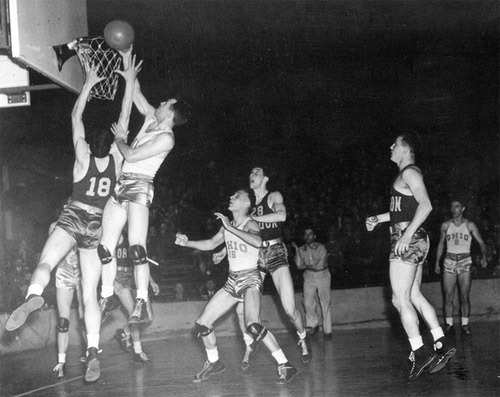 Oregon
Oregon- Ohio State action 1939
The headlines proclaimed Oregon the "national collegiate champion," and reporters expected the tournament to be an annual affair.
- However, the NABC lost $2,531 on the tournament. As a result, the committee asked the NCAA to underwrite the deficit. The NCAA agreed in return for sponsorship of the tournament in the future.
- Many years later, after the tournament had become an integral part of each college basketball season, Coach Hobson referred to the deal between the NABC and the NCAA as "one of the great bargains in sports history."
Reference: NCAA March Madness: Cinderellas, Superstars, and Champions from the NCAA Final Four (2004)
The Classic: The History of the NCAA Basketball Championship, Ken Rappoport (1979)
"NCAA Basketball Tournament Celebrates 50th Birthday: First Tournament Held at Northwestern University, March 1939," Patrick M. Quinn, University Archivist, Northwestern University |
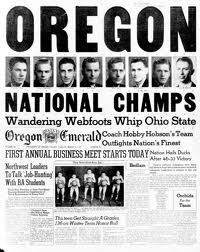
|
The Kansas-Missouri rivalry transcends the two universities and extends back to pre-Civil War times.
- "Bloody Kansas" referred to the series of violent confrontations between pro-slavery and anti-slavery forces who staged their own precursor to the Civil War.
- The fiercest area of the fighting was along the border between the Territory of Kansas and the state of Missouri in the late 1850s. Lawrence, future home of Kansas University, was the venue for some of the bloodiest skirmishes.
Moving into the 20th century, the rivalry between the two state universities became known as the Border War. One incident typifies the venom that made athletic contests between the two schools potential powder kegs.
- Let's focus on the school year of 1960-1 and start with the annual football game at Memorial Stadium in Columbia MO on November 19, 1960.
- Dan Devine's Tigers had just won at Oklahoma 41-19 to move their record to 9-0 and take over the #1 ranking in the AP poll for the first time in school history. Win the finalé over the archrival and play in a New Year's Bowl game for the national title.
- The 6-2-1 Jayhawks, relishing the role of spoilers, shocked Mizzou, 23-7. Fights broke out in the stands.
- However, one of the KU stars of the game, HB Burt Coan, was ruled ineligible by the Big Eight Conference because of illegal recruitment tactics. Kansas had to forfeit the game and its conference championship. (Both schools still count the game as a win.)
- The Jayhawk Nation had no doubt who blew the whistle on them - Missouri's AD and former football coach Don Faurot.
Fast forward to February, 1961, and the first of two annual meetings of the schools on the hardwood.
- The crowd of 8,000 in Allen Fieldhouse was in a vengeful mood when the Tigers came to town. UM C Charles Henke recalls: "Kansas fans were booing us so hard that they couldn't introduce us." The public address announcer finally calmed the crowd enough to complete the introductions, and Kansas issued an apology.
- The Jayhawks got revenge the best way possible, on the scoreboard with an 88-73 romp, their 10th straight roundball triumph over their rival.
The schedule called for Kansas to visit Missouri to end the regular season on March 11.
- The Tigers were finishing a disappointing season, entering the contest with an 8-15 record. Coach Wilbur "Sparky" Stalcup had been hung in effigy on campus when Mizzou fell to 2-10 in conference play with a loss at Iowa State. A fifth straight losing season was assured.
- Missouri wanted some solace by preventing the 17-7 Jayhawks from tying for the Big Eight title just as KU had spoiled the Tigers' dream season on the gridiron.
- Some of Missouri's irritation was directed at KU's star 6' 8" C, Wayne Hightower, who happened to be African-American. Wayne had succeeded former Jayhawks star Wilt Chamberlain as the C for Overbrook High School in Philadelphia. Like Wilt, Hightower would play many years in the NBA.
- While Missouri relied on homegrown talent, the Jayhawks had been importing recruits like Chamberlain, Hightower, and All-American F Bill Bridges from Hobbs NM. Many of the Mizzou faithful resented KU for bringing in "ringers."
- The fact that Kansas had won a national championship and played in three title games the previous nine seasons contributed to the negative feelings the Black and Gold harbored toward their border rival.
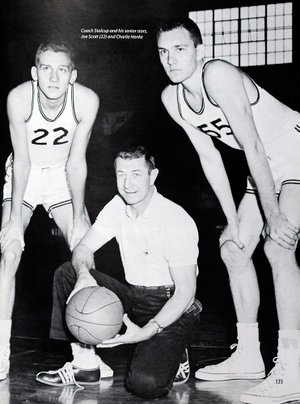
Coach "Sparky" Stalcup with captains
Joe Scott (L)
and Charlie Henke. |
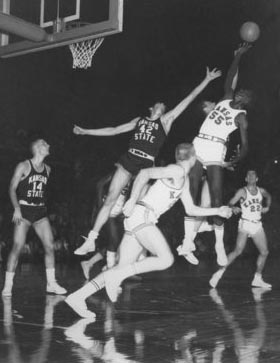
Wayne Hightower (55) in action |
The fact that the rematch was ABC's Game of the Week with Jack Buck doing the play-by-play raised the voltage inside Brewer Fieldhouse even more.
- AD Faurot, fearing an unseemly incident, stationed football players near the floor to break up any skirmishes. Many of the 3,500 in attendance wore pins declaring "All Hawkers Are Bastards."
- Several times during the game, fans threw paper cups onto the floor to protest calls.
- As the first half ended, MU senior Joe Scott leveled a Jayhawk attempting a halfcourt shot, drawing a technical foul. The crowd roared its approval as their Tigers left the court with a 41-37 lead.
The powder keg exploded five minutes into the second half.
- The opposing centers, Henke and Hightower, had been teammates during tryouts for the 1960 Olympics. Henke thought they got along well. "Apparently I was wrong," he later reminisced.
- With 14:49 remaining, Hightower drove the lane for a basket despite Henke's attempt to foul him from behind. Henke recalls, "I looked at the referee because he hadn't called a foul. I turned around just in time for him [Hightower] to smack me right between the eyes."
- The punch started a riot. Henke was hurled into the wire fencing on the baseline. "Then another one of 'em jumped in with his feet flying," he told the Kansas City Star afterwards. "Then I saw a couple of our boys knock Hightower down."
- Both benches emptied, and football players came out of the stands along with some fans. A reporter covering the game courtside recalled blood spattering onto his beige sports coat.
- Mizzou G Terry Turlington remembered popping a KU player "right in the nose." And "there must have been 100 people on the floor, and that's not an exaggeration."
- Jack Buck found himself announcing a fight in the middle of a basketball game. "Brother, they are really slugging in there. You were waiting for something to happen, hoping at the same time that it would not happen. But if finally did," he told the live audience. When order was restored after 10 minutes, he noted "more than one shiner." Both Henke and Hightower were ejected.
- Missouri held on to win 79-76. Despite missing the last 15 minutes, Henke led all scorers with 20.
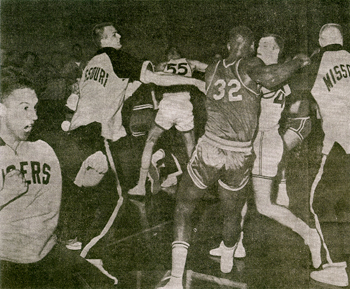
The Brawl at Brewer
Both athletic departments were embarrassed by the incident.
- Station KMBC in Kansas City planned to show a tape of the game, which was blacked out locally. Neither Missouri nor Kansas would give permission for the rebroadcast.
- KU AD Dutch Lonborg told the Associated Press a few days after the game: "If this extreme bitterness continues, we will have to discontinue playing each other, at least for a while."
- Some reporters piled on. Bob Busby of the Star wrote: "I don't want any part of any more stupidity, or having to climb my way to the press box through a cordon of National Guardsmen."
- Faurot agreed that the continuance of the rivalry needed reevaluation. However, he laid the blame for the fight squarely on Hightower and Kansas. "If any bitterness exists, it has been brought about by Kansas people on the Coan case."
When the dust cleared, though, the schools continued to compete in athletics with no interruption until 2011 when Missouri announced it was joining the SEC for the 2012-13 school year.
- The Mizzou AD announced a desire to continue playing KU each year in non-conference games.
- However, Kansas basketball coach Bill Self and AD Sheahon Zenger indicated that they plan to move on without the Tigers.
Vince Lombardi, Basketball Coach
|
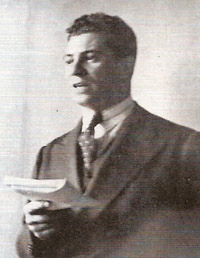 Vince Lombardi teaching at St. Cecilia
Vince Lombardi teaching at St. Cecilia |
The immortal Vince Lombardi's first head coaching job was in basketball, not football.
- Vince taught physics, chemistry, and Latin at St. Cecilia High School in Englewood NJ. He coached the line under head football coach Andy Palau, like Vince a Fordham grad.
- Palau, who also played basketball at Fordham, taught Vince the rudiments of the game that was alien to him. In particular, he taught him the zone defense because it was simple. Andy quickly learned that, while having no feel for the game, Vince was smart enough to pick up strategies and organize practices.
Vince led the Saints to a winning season, though just barely - 10 wins against 9 losses. One victory came in one of the strangest games in basketball history.
- On February 29, 1940, a strong team from Bogota (Bu-GO-ta) High School came to St. Cecilia. Coach Ev Hebel of the visitors wanted to rest his team for a playoff game later in the week.
- Hegel's attitude was understandable since his squad had trounced the Saints earlier in the season.
Hebel adopted a strategy that enraged Lombardi.
- A half-minute into the game, one of the Saints shot and missed. A Bogota player rebounded and proceeded to stand still with the ball for the remaining 7 1/2 minutes of the quarter!
- Lombardi's defenders looked to the coach, but he told them to stay back in their zone D. He figured that Hebel's tactic would give St. Cecilia its best chance of pulling the upset.
- Amidst jeers and hisses, Bogota held the ball for the entire second period as well. The teams left the court at halftime with the scoreboard still reading 0-0.
- The Saints won the second half tip and quickly took a shot but missed. Bogota rebounded and reverted to their first half strategy. Amazingly, the game was still scoreless after three quarters.
- Finally, in the last period, Lombardi signaled his team to press the ball. The contest turned into a normal game at that point. Bogota attempted seven shots but missed all of them. A lone FT prevented them from being shut out. St. Cecilia won 6-1.
Lombardi accosted Hebel after the game.
- He screamed at the opposing coach even though his tactics had backfired. Vince thought it cowardly for the better team to hold the ball and make a mockery of the game.
- Heber countered that he wanted to save his team for the tournament and make a point against zone defenses, which he despised.
- The two men had to be separated, but no blows were thrown.
Eventually, Vince coached the Saints hoopsters to a regional title. He became head football coach at St. Cecilia for the 1942 season. The rest, as they say, is history.
|
"George
Mikan vs. the Knicks"
When the Minneapolis Lakers
arrived at Madison Square Garden on December 14, 1949, for a game with
the New York Knicks, they
noticed the marquee said, "George
Mikan vs. the Knicks."
Big George's teammates kidded him in
the locker room by refusing to dress out at first.
It's
understandable why the Lakers
would be classified as a one-man team. Their 6-10, 245-pound center dominated
the early years of the NBA, leading the Lakers
to five titles in the six years from 1949-54. No MVP award was given until
1956, but he would surely have had a shelf full of them if they had started
earlier. In his career, he averaged 23.1 points and 9.5 rebounds per game.
He was elected to the Naismith Memorial Basketball Hall of Fame in 1959
and was voted one of the 50 Greatest Players in NBA history in 1996.
To
give opponents a better chance against #99, the NBA widened the lane from
six to 12 feet before the 1952 season. This was commonly referred to as
"The Mikan Rule." Teams also tried to slow
down the game. For example, Minneapolis
lost 19-18 to the Fort Wayne Pistons
in 1950 in the lowest-scoring game in NBA history. This was one of the
factors in the installation of the 24-second
shot clock in 1955.
|
|
Mikan
blossomed at DePaul University
under legendary coach Ray
Meyer. George's 34 points sparked the Blue
Demons to the NIT championship in 1945 at a time when
the NIT championship was considered more prestigious than the NCAA crown.
George
died June 3, 2005, a few days short of his 81st birthday. Shaquille
O'Neal, who knows basketball history, paid a special
tribute to #99 at that time.
|
-
There was a center jump after every made basket? (If you remember this,
you must be 90 years old!)
- A player had to raise his hand when called for a foul (and if you put
up both hands, you were called for a technical foul)? The official pointed
to the offending player and did not signal his number to the scorer's
table.
- The "key" was shaped like an actual key because the lane was
only 6' wide (in college and, until 1951, the NBA)?
- The NBA had the "3 to make 2" rule for two-shot fouls after
the opponent was over the foul limit for the quarter? If the shooter
missed either of the first two free throws, he got a third.
- A "backcourt foul" in the NBA earned two shots?
- The fouled player shot the free throw(s) from the beginning of the quarter
or half – that is, there was no foul limit that had to be reached
before non-shooting fouls earned a shot?
- The NBA had a "force out" rule (until 1976) – that is,
crowding the player with the ball out of bounds gave the offensive team
a throw in?
- Only two officials refereed a college or pro game (NBA moved to three
officials in 1978, NCAA allowed three in 1977)?
- Only 16 teams made the NCAA tournament?
- Every held ball in college basketball resulted in a jump ball (before
1981)?
- College basketball played four 10-minute quarters?
- "One-and-one" meant you got the second shot if you missed
the first shot?
- There was no three-point shot (introduced in college basketball for
experimentation in 1980, not adopted for all games until 1986)?
- Players did not have their names on their jerseys?
- There was a 45-second shot clock in NCAA basketball (1985-1993)?
|
1957
NCAA Championship Game
The 1957 NCAA championship game ranks as one of the greatest ever, perhaps
the greatest. No. 1
North Carolina (31-0) met no. 2 Kansas (24-2) before 10,500 at Municipal Auditorium in Kansas City.
North Carolina was coached by Frank McGuire.
- He brought three players from his native New York to Tar Heel
country: All-American Lennie Rosenbluth, Tommy
Kearns, and Pete Brennan.
- NC
reached the finals with a thrilling 74-70 triple overtime victory over
Michigan State the night
before.
- Little did the Tar Heels
know, but they were about to play their second 3OT game in two nights!
Kansas
was coached by Dick Harp, in his second year after succeeding
the legendary Phog Allen, who retired after winning the
1955 championship.
- The Jayhawks
had lost a heart-breaker to Indiana
in the 1956 final, 69-68.
- Harp was about to "enjoy"
a distinction that may never be equalled: losing in the finals by
one point in both your first two seasons as head coach.
- Kansas
was led by 7'0" All-American sophomore Wilt Chamberlain,
who had come to Corn
Country from Philadelphia. The remaining starters were all seniors.
- KU earned its place in the
finals with an 80-56 victory over San Francisco
that ended the Bill Russell-less
Dons' two-year title run.
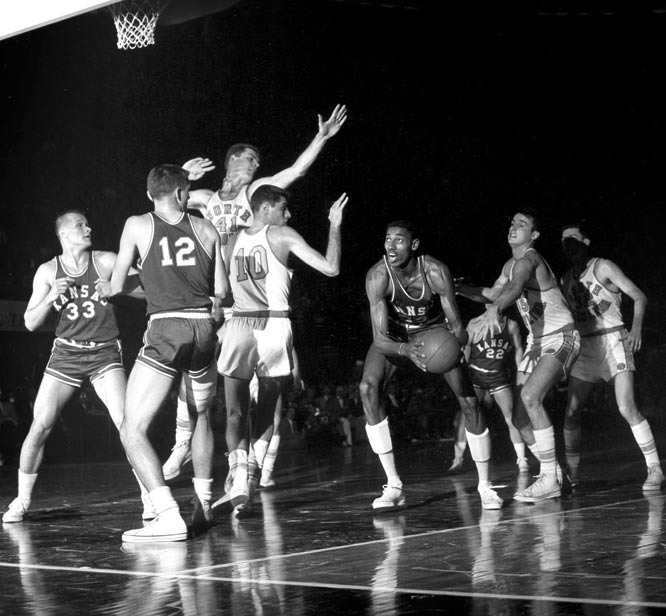
Often
#1-vs-#2 in whatever sport disappoints. This one did not.
- For the opening
tip, McGuire sent 5-11 Kearns to jump
against Chamberlain. Whether this ploy unnerved KU
is debatable, but NC jumped
to a 19-9 lead before missing its first shot.
- Kansas
finally took the lead 36-35 midway through the second half.
- The game went
back-and-forth, with neither team leading by more than three points.
- When Wilt scored with 2:16 to make it 44-41, KU
seemed in good shape.
- But a Kearns free throw with 20
seconds left tied the game at 46-46 at the end of the regulation 40 minutes.
- Rosenbluth had fouled out with 1:45 left; so NC
would have to win without its top scorer.
Each
team scored two points in the first overtime, indicative of what often
happened in the days before the shot clock.
- The second overtime was even
worse, with no scoring whatsoever. Tempers
flared several times.
- The third OT finally settled the issue. With
six seconds left and the Jayhawks
leading 53-52, NC's Joe
Quigg made two free throws, then stole a pass to Chamberlain
at the other end to seal the victory.
Rosenbluth
led NC with 20 points. Chamberlain
tallied 23 points and 14 rebounds. Amazingly, the Tar Heels
outrebounded KU 42-28.
|
|
CONTENTS
First National Tournaments - I
First National Tournaments - II
Border War Brouhaha
Vince Lombardi, Basketball Coach
"George Mikan vs. the Knicks"
Do You Remember When ...
1957 NCAA Championship Game
Basketball
Snapshots Index
Current Basketball
Magazine
Golden Rankings Home
Top of Page |
















